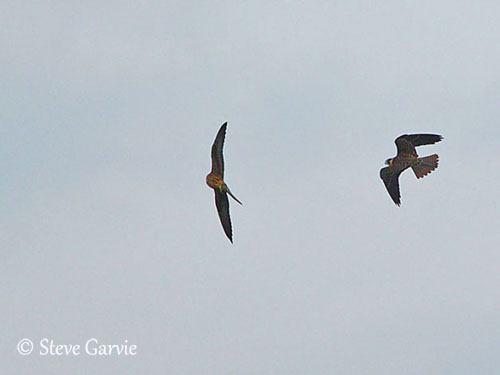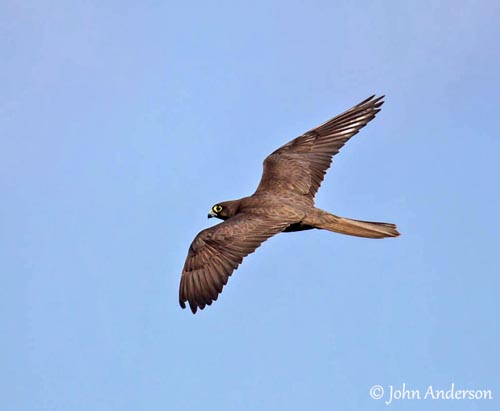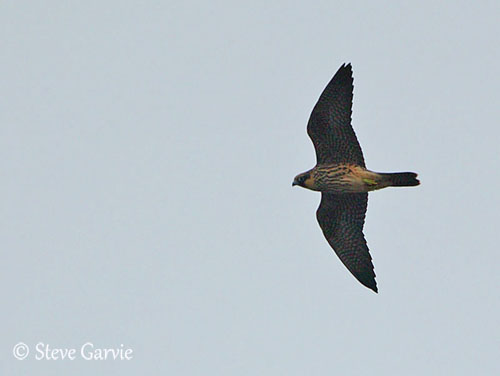
Fr: Faucon d’Eléonore
All : Eleonorenfalke
Esp : Halcón de Eleonora
Ital : Falco della regina
Nd: Eleonora's Valk
Sd: Eleonorafalk
Photographers:
John Anderson
John Anderson Photo Galleries
Steve Garvie
RAINBIRDER Photo galleries
Ingo Waschkies
Bird Photography
Text by Nicole Bouglouan
Sources:
HANDBOOK OF THE BIRDS OF THE WORLD Vol 2 by Josep del Hoyo-Andrew Elliot-Jordi Sargatal - Lynx Edicions - ISBN: 8487334156
BIRDS OF PREY OF AFRICA AND ITS ISLANDS by Alan and Meg Kemp - Struik Publishers - ISBN: 1770073698
BirdLife International (BirdLife International)
Science Daily – Your source for the latest research news
Animal Diversity Web (University of Michigan Museum of Zoology)
Wikipedia, the free encyclopaedia
Eleonora’s Falcon
Falco eleonorae
Falconiforme Order – Falconidae Family
BIOMETRICS:
Length: 36-42 cm
Wingspan: M: 90 cm – F: 105 cm
Weight: M: 350 g – F: 390 g
DESCRIPTION:
This medium-sized bird of prey is named after Eleanor of Arborea, who was a female judge in Sardinia from 1383 to her death. She had protected this species and other raptors through the 16th century.
The Eleonora’s Falcon male has dark sooty-brown upperparts. The narrow wings and the long tail are blackish above, and finely barred pale grey below, with broad black tips.
The underparts shade off into various rufous tones, with broad dark streaks on breast and underwing-coverts.
On the head, chin, throat and cheeks are white. We can see the blackish malar stripe characteristic of falcons. Forehead, crown and nape are dark slaty-grey.
The bill is black with grey base and cere. The eyes are dark brown, surrounded by greenish-yellow eyering. The short legs and the long toes are dull yellow.
The female is similar in plumage, but she is larger than male. She has blue eyering instead yellow.
The juvenile may show different morphs too. It is usually darker than adults of the same morph. However, the young pale morph falcon is paler than adults, with greyish underparts, underwing-coverts with dark spots and barred flight-feathers.
The bill is grey with darker tip and pale grey cere. The eyes are dark brown with pale grey eyering. Legs and feet are dull yellow.

VOICE: SOUNDS BY XENO-CANTO
The Eleonora’s Falcon is very vocal when hunting, although being usually quiet.
It utters fairly hard sounds “kia-kia-kia”. It frequently gives a single “kiyet”, and we can also hear “kiei-kiei-kiei” with stronger two last syllables. It also utters some “ki-ki-ki-ki” followed by shrill “kiii-kiii-kiii”. At nest, when adults are feeding the young, they give low raucous sounds.
HABITAT:
The Eleonora’s Falcon frequents small islands and rocky quiet islets, and cliff faces along the coasts. Usually, these locations are on the migratory routes of small birds. It can hunt without long distance movements. This species breeds in restricted area around the Mediterranean Basin.
On the wintering grounds in Madagascar, it frequents open forests and woodlands, wetlands, ricefields and lakes too.
RANGE:
The Eleonora’s Falcon breeds on rocky islands and islets from Canary Islands and NW Morocco, eastwards through Mediterranean Basin, Greek islands, Crete and Cyprus.
It winters in Madagascar, but also in E Africa and Mascarene islands.
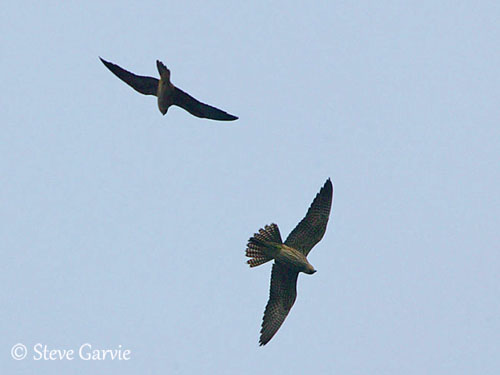
BEHAVIOUR:
The Eleonora’s Falcon hunts by soaring for long periods above the ground, with broadly open wings. But several males may hunt together during the migrations of other birds’ species. They hover and form a barrier to intercept the flying migrating birds arriving in the early morning. They swoop onto these tired birds before they can perch for resting.
This type of hunting occurs mainly during the breeding season. The preys are carried at nest and then, the male goes away for hunting again.
The male spends almost all the year flying. Sometimes, they perform rapid chases and high speeds. The beautiful dive with closed wings and tail is something superb!
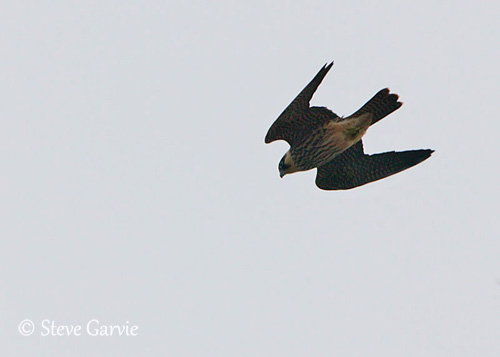
The courtship displays are often performed in groups instead in pairs. Like numerous raptors, they dive above the water. Both mates also perform the typical flight display, by flying one above the other. The bird below turns onto its back and holds the talons towards its partner without touching it but always flying.
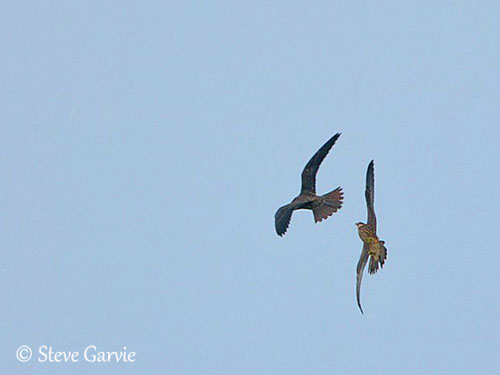
The Eleonora’s Falcon is largely migratory, and long distances flights are often made in groups.
They leave the breeding colonies between mid-October and mid-November to reach their wintering grounds in Madagascar where the rainy season occurs, involving abundance of insects.
They return to their breeding grounds in late April/May.
From recent studies, these falcons cross straight over African continent to reach Madagascar, instead to fly above the Mediterranean Sea.
However, they return to their breeding colonies by using a different route. They travel from Madagascar above the Indian Ocean to Somalia. This is a great physical effort for these amazing raptors.
FLIGHT:
The Eleonora’s Falcon has fast flight with deep wingbeats on long, narrow wings. Wingbeats are regular although slower periods are reported.
The dives on closed wings and tail are superb. It rises again with slightly down-curved or sometimes widely open wings, forming a single line with the body and the partially open or completely closed tail. It spends much time soaring slowly on almost stiff wings above the cliffs where it breeds. It may hover too.
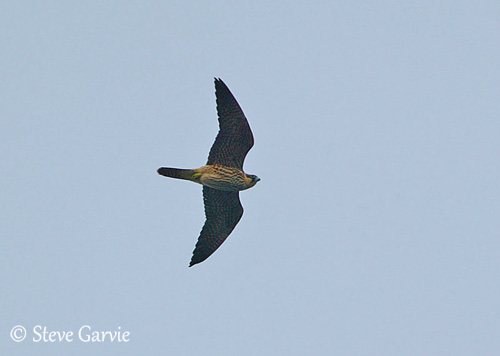
REPRODUCTION:
The Eleonora’s Falcon breeds in colonies of 4 to 24 pairs, occasionally up to 300 pairs. They breed fairly late in the season, from mid-July to August.
It often breeds on islands and rocky islets, or cliff faces along the coast. The nest-site can be in hollow or on rocky ledge, or even on the ground, concealed in crevices on under vegetation. At colonies, the nests are sometimes only a few metres apart. Both mates defend the nest area and chase away intruders such as Laridae and Corvidae approaching the nest.
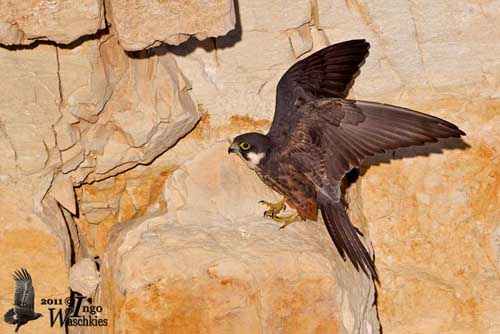
The female lays 2-3 creamy-white eggs with small dark markings, at 2-3 days interval. She incubates during 28-30 days. At hatching, the chicks are covered in creamy-white down. The female protects and broods them during about 8-10 days, while the male is hunting. It brings the preys at nest where the female feeds the chicks. The male remains in the surroundings and sometimes close to the nest before to fly away.
The young fledge about 37 days after hatching. They often leave the colony two weeks later. They will be sexually mature at 2-3 years old.
DIET:
The Eleonora’s Falcon feeds primarily on large flying insects and small passerines. It may also hunt small mammals and lizards. It often hunts in the early morning and at dusk, and nocturnal hunting has sometimes been reported.
PROTECTION / THREATS / STATUS:
The Eleonora’s Falcon has relatively stable populations, in spite of declines due to human activities and chick and eggs collecting for human consumption in some parts of the range. Tourism along Mediterranean coasts involves lower breeding success. However, this species responds very well to protection measures, and is not currently threatened.
